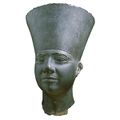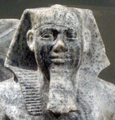مسخنت
| مسخنت | |
|---|---|
 مسخنت كإمرأة الرحم على رأسها بقرة رمزية | |
| إلهة الولادة | |
| الرمز | رحم البقر |
| Consort | Andjety |
مسخنت أو مسخنت'MeskhenetMesenet, Meskhent, و Meshkent ظهرت مع إلهات الولادة أثناء عملهن وخاصة مع "حكات" وكانت كذلك إلهة للقدر والحظ والمصير .[1]
. . . . . . . . . . . . . . . . . . . . . . . . . . . . . . . . . . . . . . . . . . . . . . . . . . . . . . . . . . . . . . . . . . . . . . . . . . . . . . . . . . . . . . . . . . . . . . . . . . . . . . . . . . . . . . . . . . . . . . . . . . . . . . . . . . . . . . . . . . . . . . . . . . . . . . . . . . . . . . . . . . . . . . . .
في الأساطير
In ancient Egypt, women delivered babies while squatting on a pair of bricks, known as birth bricks, and Meskhenet was the goddess associated with this form of delivery. Consequently, in art, she was sometimes depicted as a brick with a woman's head, wearing a cow's uterus upon it. At other times she was depicted as a woman with a symbolic cow's uterus on her headdress.
Since she was responsible for creating the Ka, she was associated with fate. Thus later she was sometimes said to be paired with Shai, who became a god of destiny after the deity evolved out of an abstract concept.[2]
It was said that Meskhenet was present at the birth of triplets, and foretold in their fates, that they would each be pharaohs - the triplets in question were Sahure, Userkaf, and Neferirkare Kakai, who were the first pharaohs in the fifth dynasty (although Userkaf was not the sibling of the other two, but their father).
Meskhenet also was believed to be the earliest wife of Andjety the god of rebirth in the underworld. Andjety appears to have been worshipped since pre-dynastic times at Andjet, and is thought by most Egyptologists to be the god who eventually became Osiris.
معرض الصور
أنظر أيضا
المصادر
- ^ مسخنت
- ^ Wilkinson, Richard H. (2003). The complete gods and goddesses of ancient Egypt. London: Thames & Hudson. ISBN 0-500-05120-8.
روابط خارجية
| مسخنت
]].

